The Brilliant Easy Technique to ensure the Feedback is Helpful, Constructive, and has positive changes in Personal Development
The AID feedback model is a great tool in a workplace environment. It helps you to increase your employees’ self-confidence. And, for sure it will increase the overall general employee performance.
Every company expects employees to work on time and bring positive value through their actions and behaviours. Companies desire to have their employees be at their most effective and efficient at all times. That’s why companies always try their best to share information about the company’s purpose, mission, and vision. With everyone believing in the same goals then the company’s goals will be right on the way. However, it is a bit easier to say than to do, but of course, it is possible.
The right tool can bring a huge impact.
It’s a universal truth that not everyone inside the company sees the same vision or performs at their best. Every manager needs a system that can help make the employees’ jobs more efficient in the best possible way. One of the right tools that tend to be a great option is the AID Feedback Model.
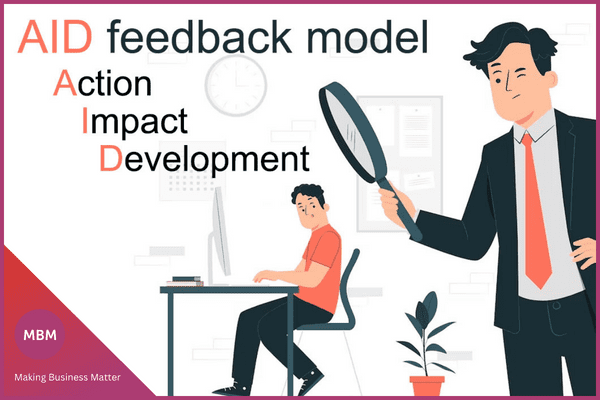
Why Employees Need AID Feedback Model
In today’s company environment, underperformance employees have become a general problem and topic of discussion among businesses of all sizes. The reality is that employees fail for many various reasons. As a manager, you can always contribute to motivating the employees to their performance improvement. And for this purpose, you can use the Aid feedback model as one of your possible solutions.
Employees, in general, are not telepathic. It means they cannot read your mind. So, you need to tell them what you want them to know. It is including what you want them to change or improve about the way they work. And, you need to go into detail on what specific things they need to do differently, and how they can do it. As a manager, you need to tell all this stuff to them directly. And the AID feedback model will be a great tool option to choose from many feedback variances.
The AID feedback model is very special. It helps you to focus and bring up a specific action that occurred in the past. And then inform the employee about the impact of this action on the company. Later, you can provide clear guidance related to the topic you discuss.

Who Created the AID Feedback Model?
Andi Roberts is the founder of this methodology; he has been working as a leader and training leaders for twenty years. The AID model is simple but powerful because it gives a clear direction. It can be used either for positive moments or any particular moment that needs corrective instruction. The AID Feedback Model consists of three elements: action, impact, and development, or desired behaviour. Let’s take a look at how you can use this AID feedback model.

Action:
You need to focus on the employee’s specific action or behaviour that you want to give feedback on. Try to avoid using your own interpretation but explore what you observed and heard.
Questions Example:
– What did you do in the presentation with Mr. A last Friday?
– What did you see when you were in the kitchen at 1 AM last Friday?
Statement Example:
– You were five minutes late in this morning’s presentation with Mr. A.
– You were not supposed to be in the kitchen at 1 AM last Friday.
In this phase, it is important for you to use a clear question or statement. You need to make it direct to the point so the employee will clearly understand which situation you are referring to.
Impact:
It is important to note that you need to make the employee aware of the impact of their actions. As in the previous phase, make sure you make it detailed and clear.
Example:
– Every time we created a bad image for our client it didn’t just represent our own selves. It also represented the company’s image. That’s why it is important to keep on time in every situation, especially in presentations or meetings.
– I know the reason why you were in the kitchen at 1 AM last Friday. You were following up on some customer late-night orders for dinner, and this was for an emergency case. I want to let you know if this was a good initiative. Actually, in a general case, it brings a good effect on our restaurant’s performance.
Try to be fair, when you need to appraise them for something good they have done then let them know if it is a good thing. However, if it is not a good thing, try not to express your emotion through negative words.
Development or Desired Behaviour:
You need to remember that giving and receiving feedback is key to engaging employees at different levels. When you do it in the right way, then it is possible to unlock an outstanding performance of the employee. So, keep in mind that the purpose of the AID feedback model is to boost productivity and achieve better results.
Example:
– Thank you for giving extra effort. You’ve been doing a great job by placing customer needs in the first place. I really appreciate it. You set a great example for everyone on the team. Keep it up!
Normally, it will be easy when you face a positive situation. However, it will be hard to deal with when it comes to a negative situation and special attention will be needed. Once you face this kind of situation it is because of giving negative feedback in a poor manner. And one full of emotion will surely be unhelpful.

Probably you have this kind of question right now. A question is similar to “How can negative feedback be given in an appropriate positive way?” The answer is yes; we can do it. There’s a way. It’s tricky. However, if it’s delivered properly so the message will be effective and you even can make the employee grateful for it.
You can create development guidance and you need to use a standard critique. You also better avoid any strong judgmental and punishment words. And then you can put guidance along with your words.
Example:
– I would like you to arrive on time at any future meeting or presentation. In case you think that you may be late because of an important reason, then you can let me or another supervisor know, so we can back you up there.
What Are the Different Feedback Models?
There are many variations of feedback models, methods, and tools that can help you perform the right feedback. Here, we will share the five most popular feedback models:
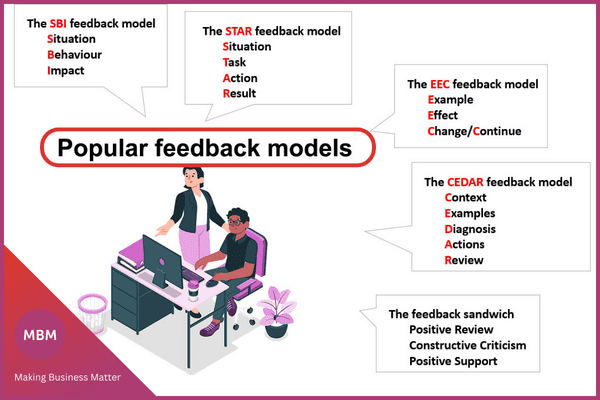
1. The SBI Feedback Model
SBI offers an easy way to structure the feedback. It provides a clear statement. And it is usually used for a positive kind of feedback or appraisal. This kind of feedback does not include any recommendations for future action. That’s the difference between SBI and AID feedback model, however for a positive situation, it is good to use.
Situation
You need to go into detail about the specific situation that you are referring to. Make sure you avoid generalities, as that can lead to confusion.
Example: Last Friday, you had a project presentation with Mr. A.
Behaviour
Bring up a precise behaviour that you want to discuss or give a comment on it.
Example: You brought a prototype model as your sample when you did your presentation.
Impact
Explain what kind of impact the employee’s behaviour had on you, the team, or the company.
Example: Mr. A is happy with your presentation, and he placed an order of 100 products in advance for this project.
Click the below image for a larger version:

2. The STAR Feedback Model
Giving feedback is an important matter, especially when you need to deal with problems. As a manager, it is crucial to give feedback in a constructive way. This is a good way to avoid demotivating the employee. However, it will still make the employee aware of their own issues or mistakes. Same with SBI, the difference between the STAR feedback model with the AID feedback model, it has no recommendations for future situations.
Situation
Describe the specific situation—what, when, and who—being as specific as you can.
Example: Last Friday, you had two clients on your list, Mr. A and Mrs. B.
Task
Explain the task you were expecting. It is important so the employee can understand the context you are trying to bring up.
Example: You were supposed to send some detailed project information. Especially the information about the person who will be in charge of their project directly.
Action
Go into detail on how the employee’s action did not meet company expectations.
Example: We always need to distribute the information within 6 hours to the clients. And in this case, they were waiting for it until night since morning time.
Result
The final stage is specifying the direct result or outcome of the action.
Example: Today we receive their formal complaint through the Bulletin board. It’s not only our company leaders who know about it. But it also creates a bad reputation in public view.
It is important to let the employee know what their action impacted and what they were supposed to do at that particular moment. It can be fulfilled by using the STAR feedback model. Companies can ensure that the information they want to distribute is well received by the employee. Especially in a negative situation.
3. The EEC Feedback Model
The next feedback model that we want to introduce here is EEC (Example, Effect, Change). The EEC model will help you to structure constructive feedback. Now, let’s review this kind of feedback from how similar it is to the AID feedback model.
The EEC model can be used for positive events as well as not-so-great events. It’s useful when you, as a manager, need to give some coaching in the most appropriate way. This coaching pattern also can be found in the AID feedback model. It has detailed instructions or recommendations for future action.
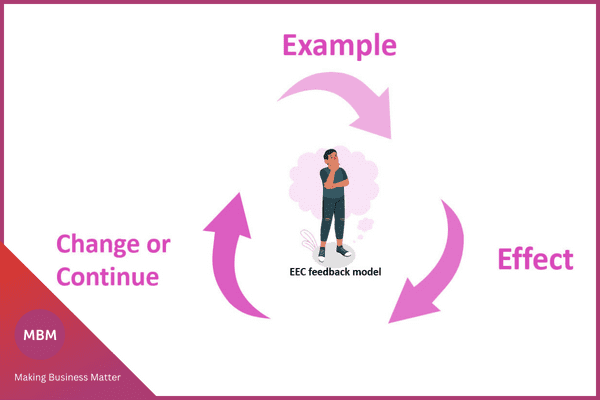
Using the EEC model, similar to the AID feedback model, we can set up an approach to deliver quality feedback, especially in a negative situation. You need to choose the right statement. Suitable words that can deliver information in a way it can encourage the employee to accept it. Or it can make the employee learn from it and, in the end, make the employee decides to make a change for better action in the future.
Keep it simple like that. Remember to not put some emotional phrase in your statement. Make it clear information. It will ensure that the employee understands and accepts your information without getting defensive or hurt.
Example
Start with a certain action or event you want to talk about.
Effect
Be clear about the effect of this action on you, the company, or even the client.
Change/Continue
Conclude your session. Let the employee know that the action is good and should continue in the way they do. Or the action should stop and need some improvement on it.
Now, you may agree with the statement that this EEC model has a similar pattern to the AID feedback model.
4. The CEDAR Feedback Model
What is the difference with this next feedback model we are going to discuss? The answer is this model has a collaborative step in it. It has an open discussion session. It makes it possible for the employee to share their point of view. This kind of open discussion is one thing that the AID feedback model doesn’t have.
Remember, even if you as a manager set a space for the employee to speak up. Or you give them room to share their opinion. It doesn’t mean the process always will be 50:50 between your portion to give or lead the discussion. Or a portion to split between appraisal and criticism. Of course, you are the one who will take control of all sessions. So, it will always be your choice to decide your own ratio to do this session.
Let’s take a look at each stage of the CEDAR feedback model:
Context
In this first stage, you need to set up the context that can lead to a clear perspective. Generally, it will always be good to open with something like describing how important employee performance is for the company. This kind of context will be good to build their self-awareness. And for sure it will be a good sign for the whole feedback session.
Sample: You know how important customer service is for a company, you should know if it is very important.
Example
Bring up a specific case to illustrate the situation that you want to discuss clearly.
Sample: There are several complaints that occurred this week. Some of them seem weird. Let’s take a look at Mr. A and Mr. Z’s complaints.
Diagnosis
Explore the reason behind the employee-specific action. Important to note, when you want to bring up a positive case, it’s usually good for you to take the lead in this discussion process. And you need to use more appraisal statements to highlight the outcomes. However, if you want to bring up a negative case. It’s better to put the employee in charge. It is because you need more information from them. Specifically, the detailed information about what really happened behind those cases. So it’s better to let them lead the session.
Sample: Yesterday Mr. A gave a complaint about the taste of our chicken teriyaki menu. And you took initiative to change his food with another menu on the list. I am wondering the reason why you do that. Because usually, our staff changes the food with the same menu. But you offer the customer to choose another menu on the list. However, actually, that is a good thing for this particular case.
Sample: Yesterday, Mr. Z gave complaint about the taste of our chicken teriyaki menu. And you took initiative to offer the customer two kinds of different menus to take away. May I know why you do that?
Actions
Once you get all the information you need, now you can set up a guideline. You need to give clear instructions about what to do and what to not. Make it more directive. And remember that not every employee understands the situation or what to do.
Sample: For complaint cases, please be aware of the budget. We can offer a compliment. We can provide another service within 50% of the cost of each menu. The menu that they have complained about. This should be the exact guidance that needs to be followed. However, in case you think it needs further action because of a specific reason, then you can contact your supervisor in charge at that time. And ask for written permission to do the things that you think suit that particular complaint.
Review
Following up on stage to support the progression of this feedback is very crucial. Regular meetings to track progress are always a good option.
5. The Feedback Sandwich
There is a classic technique. It’s a special technique that managers can use to effectively and comfortably deliver positive information and criticism all at the same time. It is the sandwich feedback model.
Why is it called a sandwich? Because it has layers on it. We can simply say it’s a sandwich. It is delivered with a positive review at the beginning of the session. Then you put constructive criticism in the middle of the session. And you close it with positive feedback or praise. Similar to the AID feedback model, the feedback sandwich also has three elements on it.
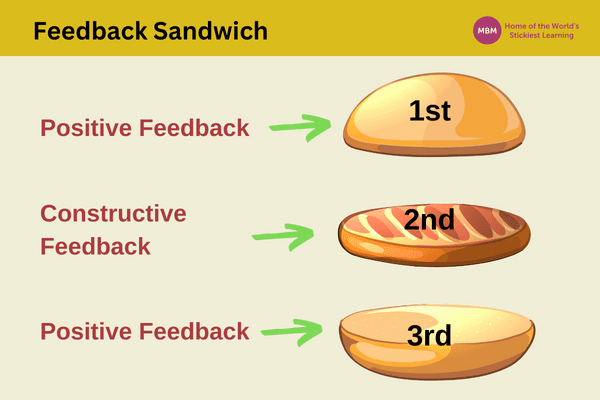
It is very classic and has pro contra, however, it works. Once you use it effectively it can help to soften the whole process. You can make it more comfortable for delivering criticism. And you also can keep getting a good ending. It is because you close the whole session with a positive review or statement. But you need to be aware because if you deliver the information improperly then the employee will only accept and be aware of positive praise. The steps are as easy as in the AID feedback model, however, the difference is the feedback sandwich is usually used for giving negative feedback.
Example:
– You were fast to handle last night’s complaint from Mr. A.
– It was not a good option, to offer him two kinds of menus for takeaway.
– However, this customer promotes us on the city bulletin board. He shares what he gets from complaining to us, which is good for the restaurant’s reputation.
The Differences at a Glance
For a better understanding, please view the table below to get more information about the differences between each feedback model.
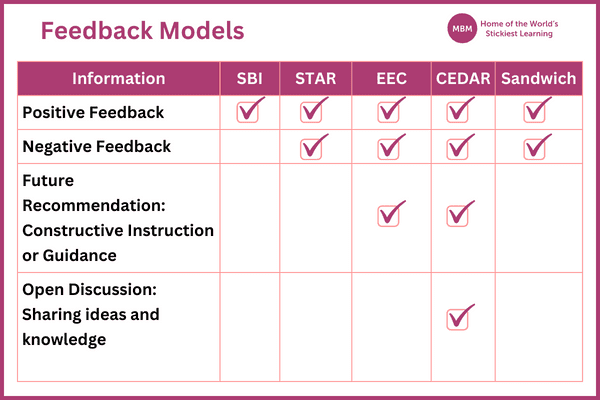
What Does AID Stand for in Appraisal?
Most companies perform a traditional performance appraisal system. They provide an AID feedback model to the employee. And it is good for their employee performance. The AID feedback model is a great tool that can be used in order to motivate, and give special support. And also it can help give corrective instruction for better improvement.
AID and Appraisal look similar. However, appraisal seems more strict than the AID feedback model. Because it is written and can be distributed with a judgmental evaluation. While the AID feedback model tends to be informal, on the spot, and close to the time of the actual event. Appraisal tends to be formal and regularly within months or a certain period.
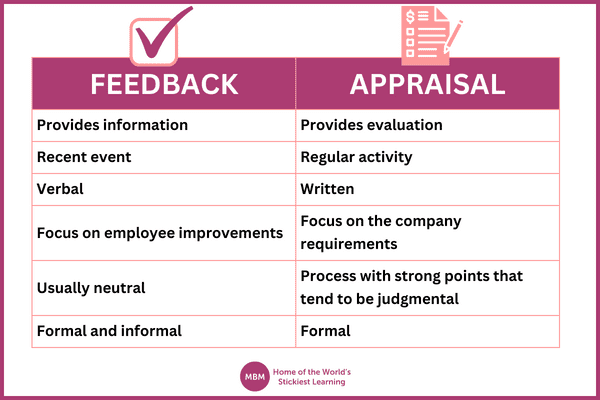
In the workplace. The AID feedback model is a vital method to ensure everyone in the company is on the same page. It helps to keep everyone on track and create a better work environment and relationship. And of course, it supports the company’s growth.
So, it is better for every company or manager to be consistent in using this tool for routine activities or reviews. It’s important to note that it surely will help either employee improvements or overall company productivity.
Enjoyed this article? Engage with us on Facebook.




